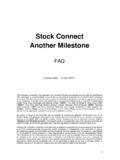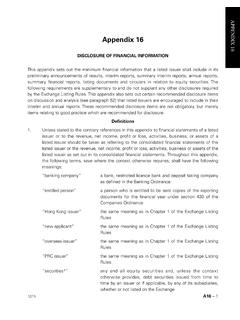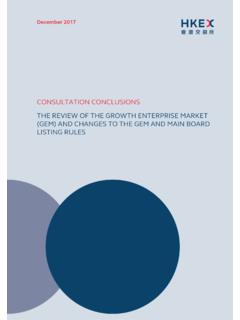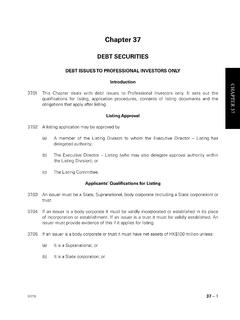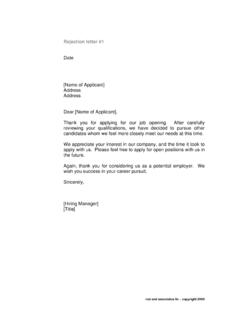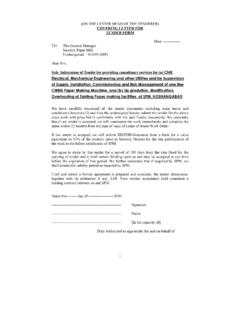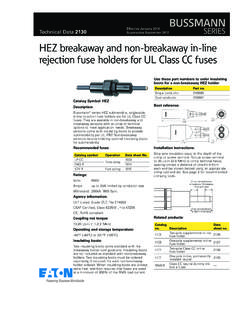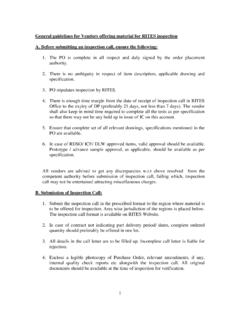Transcription of HKEx GUIDANCE LETTER HKEx-GL68-13 (December 2013) …
1 1 HKEx GUIDANCE LETTER HKEx-GL68-13 (December 2013) (Updated in June 2015) Subject GUIDANCE on suitability for listing Listing Rules and Regulations Main Board Rules , GEM Rules , Related Publications HKEx-LD8-2; HKEx-LD43-3; HKEx-LD46-1; HKEx-LD46-2; HKEx-LD50-5; HKEx-LD51-1; HKEx-LD51-3; HKEx-LD69-1; HKEx-LD92-1; HKEx-LD96-1; HKEx-LD97-1; HKEx-LD107-1; HKEx-LD19-2011; HKEx-LD30-2012; HKEx-LD37-2012; HKEx-LD73-2013; HKEx-LD92-2015; HKEx-RL12-06; HKEx-RL19-07; HKEx-RL20-07; HKEx-RL21-07; and HKEx-RL25-09. Author IPO Transactions Team Important note: This LETTER does not override the Listing Rules and is not a substitute for advice from qualified professional advisers. If there is any conflict or inconsistency between this LETTER and the Listing Rules, the Listing Rules prevail.
2 You may consult the Listing Department on a confidential basis for an interpretation of the Listing Rules or this LETTER . 1. Purpose This LETTER provides GUIDANCE on the factors that the Exchange would take into consideration when assessing whether an applicant and its business are suitable for listing under Main Board Rule (GEM Rule ). The Exchange considers a number of factors when assessing an applicant s suitability for listing. We have published various listing decisions and rejection letters, as referred to above, to provide transparency to the market. This LETTER is intended to assist applicants and their advisers by consolidating the factors included in these listing decisions and rejection letters.
3 (Updated in June 2015) This LETTER sets out examples of factors that have been considered by the Exchange in the past and published as GUIDANCE on the Exchange s website, and they are not exhaustive. (Added in June 2015) 2. Relevant Listing Rules Main Board Rule (GEM Rule ) states that both the applicant and its business must, in the opinion of the Exchange, be suitable for listing. Main Board Rule (GEM Rule ) states that suitability for listing depends on many factors. Applicants for listing should appreciate that compliance with Listing Rules may not itself ensure an applicant s suitability for listing. 2 GEM Rule also states, by way of example, that an applicant whose assets consists wholly or substantially of cash or short-dated securities ( securities such as bonds, bills or notes which have less than one year to maturity) would not normally be regarded as suitable for listing, except where the applicant or group is solely or mainly engaged in the securities brokerage business.
4 3. GUIDANCE on suitability When vetting a listing application, the Listing Department focuses on an applicant s eligibility for listing ( whether the financial requirements are met; compliance with law, rules and regulations), suitability for listing ( whether matters on sustainability of the business; reliance on a parent company; suitability of directors, including potential persons of substantial influence are satisfactorily addressed), and whether there are any material disclosure deficiencies. (Updated in June 2015) There is no hard and fast rule in determining what would render an applicant and its business not suitable for listing.
5 Each case is determined on its own individual factual circumstances. (1) suitability of director and controlling shareholders Having a past non-compliance or conviction record does not necessarily mean that a person cannot be accepted as a director of a listed company. However, in the case where the past record or conviction raises serious concern on an individual s integrity, and the individual is likely to exert substantial influence on the applicant after listing ( a controlling shareholder and director), there may be concern as to the applicant s suitability for listing and the suitability of the individual to act as a director under Main Board Rules , and (GEM Rules , and (1)).
6 (Updated in June 2015) Where a person is a controlling shareholder, his majority vote as a controlling shareholder is likely to be decisive in the appointment of the directors of the applicant. It will accordingly be highly likely that he will be able to exert substantial influence over the operation and management of the applicant even if he is not formally appointed as a director, or has previously resigned as a director. The issue of the applicant s suitability therefore may not be solved by that person refraining from acting as the applicant s director. (Updated in June 2015) Relevant listing decision: HKEx-LD96-1 (2) non-compliances The Exchange considers that systematic, intentional, and/or repeated breaches of laws and regulations by an applicant may affect its suitability for listing.
7 The Exchange will take into account the following factors in determining the impact of non-compliance on an applicant s listing: 3 (i) the nature, the extent and the seriousness of the breaches; (ii) the reasons for the breaches, whether they were intentional, fraudulent, due to negligence or recklessness; (iii) impact of the breaches on the applicant s operation and financial performance; (iv) rectification measures adopted; and (v) precautionary measures put in place to avoid future breaches. In cases such as non-compliant bill financing arrangements, the Exchange will expect the applicant to have demonstrated for a reasonable period (normally 12 months) that (a) it would be financially sound and could operate without reliance on the non-compliant bill financing arrangements; and (b) it has effective internal control to avoid future non-compliance of a similar nature.
8 In other cases where the non-compliances do not have a direct impact on the financial position of the applicant ( failure to obtain the necessary licence, approval or complete the necessary registration required by law), where the non-compliances had been serious, listing was only approved after the applicants had demonstrated continued compliance for a reasonable period of time. Where it is determined that the material non-compliance incidents can be resolved by way of disclosure, the Exchange expects the applicant to follow GUIDANCE LETTER HKEx-GL63-13. Relevant listing decisions: HKEx-LD50-5; HKEx-LD97-1; and HKEx-LD19-2011 (3) deteriorating financial performance The Exchange is of the view that the assessment of suitability is a continuous process and that the applicant must remain suitable for listing at the time of listing, taking into account the actual performance after the latest audited period, profit forecast and such other projected information submitted by the applicant in relation to its business and financial position after listing.
9 Examples of deteriorating financial performance that may give rise to a concern as to suitability include: (i) deteriorating financial performance subsequent to the track record period Even if the applicant can meet the relevant requirements of Main Board Rule during the track record period, any deteriorating financial performance subsequent to the track record period may be a strong indicator of a fundamental deterioration of commercial or operational viability, which goes to the heart of sustainability and suitability for listing. 4 Relevant listing decision : HKEx-LD73-2013 (ii) track record results are not indicative of future performance in light of significant profit drop in its profit forecast A significant decline in the applicant group s forecast profit together with an engagement in new business through acquisition may also render the applicant not suitable for listing, as the track record results may not be indicative of the applicant s business going forward.
10 Relevant rejection LETTER : HKEx-RL19-07 (Updated in June 2015) (4) reliance on parent group / connected persons / major customer When reviewing a reliance issue, the Exchange will take into account the degree of dependence. Where the degree of dependence is excessive, this would translate into a concern on suitability for listing. Examples of reliance that may give rise to a concern as to suitability include: (i) reliance on a parent group for certain important functions such as sales and procurement functions; or financial and operational reliance on the applicant s parent. Paragraph 27A of Appendix 1A to the Main Board Rules (Paragraph 27A of Appendix 1A to the GEM Rules) provides that the listing document should include a statement explaining how the applicant is satisfied that it is capable of carrying on its business independently of the controlling shareholder after listing, and particulars of the matters that it relied on in making such statement.


